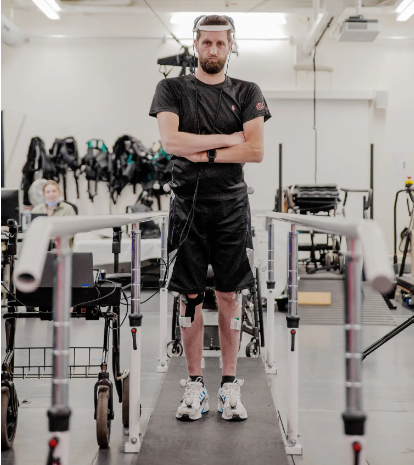A study published today, Wednesday, reveals that a Dutch man who suffered a spinal cord injury in a bicycle accident 12 years ago is now able to walk again thanks to stimulators implanted in his brain and spinal cord. The study shows that Jan Ossekm can walk again by pressing a button that stimulates his spinal cord, allowing him to stand and take steps. Gregoire Courtine, who helped lead the research, stated in an interview with USA Today that the stimulation from both ends of the spinal cord restores communication between the brain and the spinal area that controls leg movements, thus enabling more natural walking.
Dr. Jocelyne Bloch, a co-supervisor and neurosurgeon at the University of Lausanne in Switzerland, remarked, "It was science fiction in the beginning, but it has become a reality today."
**A New Life**
After a period of training, and possibly because his spinal cord was not completely severed, Ossekm, 40 years old, can now take a few steps on crutches, even without the stimulators. He is able to walk between 100 and 200 meters, equivalent to the length of one or two football fields. Ossekm said in a media call, "For 12 years, I have been trying to stand on my feet again."
**Renewed Hope**
Although Ossekm is the only person whose results using the stimulators have been published, researchers hope to ultimately assist many stroke and spinal cord injury patients in getting up from their wheelchairs. Standing also helps improve functions such as bladder control, blood pressure, and sweating.
**The Beginning**
Researchers discovered in the 1980s that stimulators could improve movement in individuals with specific diseases and injuries. Over the past twelve years, several medical groups have worked to better understand the signals between the brain and muscles, enabling more precise implantation of stimulators to maximize their effect. The new research, published in Nature, is the first to stimulate both the spinal cord and brain, allowing for the re-establishment of signals disrupted due to his injury. The pulses are timed to allow Ossekm to move each leg independently, providing a natural-looking gait rather than the mechanical gait produced by previous stimulation methods, as noted by Courtine, a neuroscientist and professor at the École Polytechnique Fédérale de Lausanne. He added, "The technology is still in its infancy, although it is a remarkable technique."
**Learning to Walk**
Ossekm needed to relearn how to walk naturally using the individual stimulation device. Both Courtine and Bloch described the process as being "like a small child, but he learned quickly and took natural steps on the first day of rehabilitation after the second implant."
**Portable Treatment**
The team plans to shrink the devices necessary to operate the system, which Ossekm currently carries in a backpack. Courtine stated that while this is suitable for laboratory research, it needs to be much smaller to be functional in the real world. The team hopes to launch a clinical trial in about a year, likely in the United States. Stimulation has not yet been approved for patients with spinal cord injuries.
The team described the process as follows: "If your brain does not know where your body parts are, how can it generate a complex pattern to tell you to reach where you want to go."
**Natural Sensation**
Ossekm confirmed that he now has a sense close to normal feeling in his left leg and can feel that he is exerting pressure on the ground with his right foot while walking, "allowing me to take a good step."




